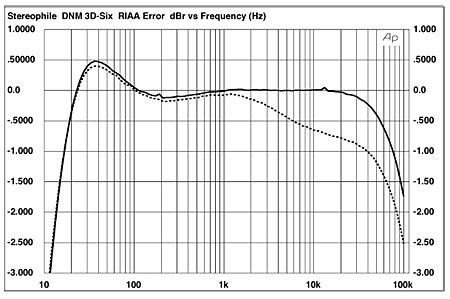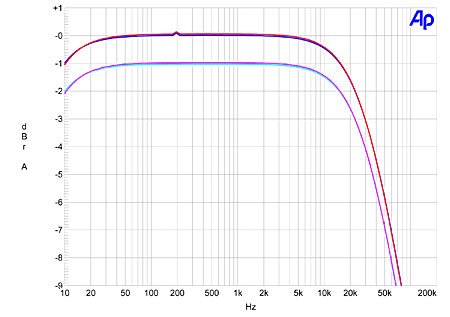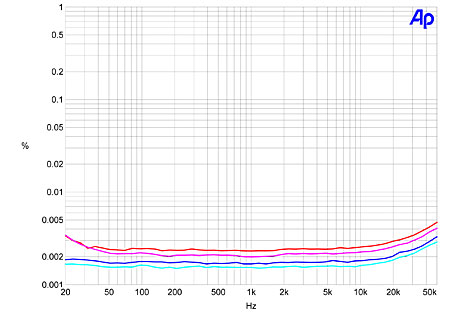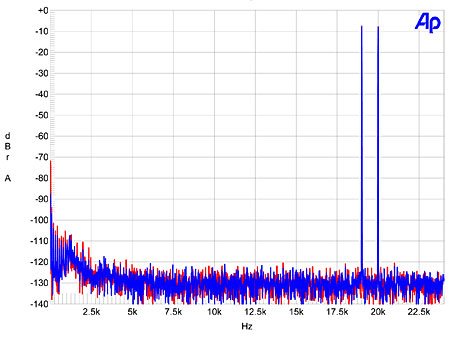| Columns Retired Columns & Blogs |
DNM 3D Six preamplifier Measurements
Sidebar 3: Measurements
I measured the DNM 3D Six's measured behavior using Stereophile's loaner sample of the Audio Precision SYS2722 system (see the January 2008 "As We See It" and www.ap.com), as well as my vintage Audio Precision System One Dual Domain. Like Art Dudley, I found that I had to place the power supply as far away as possible from the preamplifier chassis to avoid injecting hum into its output signal. Also, as AD had found in his earlier report on the 3D Primus, the preamplifier weighs so little that it's impossible to operate its pushbutton Mute control without using your other hand to hold the unit still.
Looking first at the 3D Six's phono stage, only the Disc 2 input was operative on this sample. It preserved absolute polarity (ie, was non-inverting), and the voltage gain measured at the Record Out jacks was 48.9dB, which is midway between the 40dB typical of a moving-magnet stage and the 60dB of a typical moving-coil stage. (Another 16dB of gain was available from the line stage.) The input impedance was just over 1000 ohms at low and midrange frequencies, dropping very slightly but inconsequentially to 857 ohms at 20kHz, which will be compatible with most MC cartridges. The unweighted, wideband signal/noise ratio (ref. 1kHz at 500µV input, as is usual for a MC input) was 43dB, increasing to 54dB when A-weighted. This modest figure was due to the presence of odd-order power-supply harmonics, picked up by the unshielded circuitry from the remote power supply, even though I had placed it on the floor well way from the preamp.
Phono-stage overload margins (again measured at the Record Out jacks, and ref. 1kHz at 500µV, the standard for a MC input) were extraordinarily good, at 39–40dB at low and midrange frequencies, decreasing slightly to 37.6dB at 20kHz.
The RIAA equalization error, assessed at the Record Out jacks, is shown in fig.1. The left channel (solid trace) is extremely flat between 100Hz and 20kHz, with then a gentle rolloff at ultrasonic frequencies. The right channel, however, shelves down above 1kHz, reaching –0.75dB at the top of the audioband. This imbalance may not be audible, but it does suggest that the right channel's RIAA network has an out-of-specification resistor. At low frequencies, both channels peak slightly in the midbass before rolling off to reach –3dB at 12Hz. Phono-stage channel separation (not shown) was 64dB R–L at 1kHz, 80dB L–R; it worsened slightly at both frequency extremes, but was still greater than the inherent separation of typical phono cartridges.

Fig.1 DNM 3D Six, phono-stage RIAA error, measured at Record Out jacks (0.5dB/vertical div., right channel dashed).
Turning to the 3D Six's line inputs, these, too, preserved absolute polarity, and the input impedance was 30k ohms across the audioband. The output impedance was a usefully low 75 ohms at all frequencies. It appears that there are two hard-to-access multi-turn pots associated with every input. These can be used to adjust the left- and right-channel gains independently from a maximum of 16.4dB to a minimum of unity. The maximum gain of the Aux 1, Aux 2, and Direct inputs as set for AD's auditioning was just 0.9dB, which proved more than sufficient for his Sony SACD player. All the measurements were performed in this condition.
The line-stage frequency response, taken into high (100k ohms) and very low (600 ohms) loads, with the volume control set to its maximum, is shown in fig.2. Gain matching between the channels is excellent. The output is down 1dB at 10Hz and 1.5dB at 20kHz. The high-frequency bandwidth increased very slightly at lower volume-control settings; at a setting of "8," the output was now down 1.5dB at 24kHz. The audible difference will be inconsequential, however.

Fig.2 DNM 3D Six, line-stage frequency response with volume control set to maximum gain at 1V into 100k ohms (left channel blue, right red) and 600 ohms (left channel cyan, right magenta). (0.25dB/vertical div.)
Channel separation (not shown) was better than 70dB in both directions at 200Hz, but decreased with increasing frequency to just 32dB at 20kHz, due to the usual capacitive coupling somewhere in the circuit. The line stage's wideband, unweighted S/N ratio, measured with the input shorted and the volume control set to its maximum, was 79.2dB ref. 1V output, increasing to 93.5dB when A-weighted.
Fig.3 plots the percentage of THD+noise in the DNM's output against output voltage into 100k and 600 ohms. Even into the punishingly low impedance, the preamplifier doesn't clip (defined as 1% THD) until more than 10V RMS. The downward slope of the traces in fig.3 indicates that the distortion lies beneath the noise floor up to the clipping point. Plotting the THD+N percentage against frequency at 2V, about the highest level the preamplifier will be asked to deliver in practice (fig.4), indicates that the distortion starts to rise above the noise only at ultrasonic frequencies. Even into 600 ohms, the spectrum of the 3D Six's output with a 1kHz tone at 1V (fig.5) shows no distortion products. What can be seen in this graph are noise components at the odd harmonics of the 60Hz AC frequency. Only the very-lowest-frequency of these rise above the –100dB line, so they are most likely inconsequential—but I couldn't further reduce their level due to the 45" length of the umbilicals connecting the power supply to the preamplifier chassis.

Fig.3 DNM 3D Six, distortion (%) vs 1kHz output level into (from bottom to top at 10V): 100k, 600 ohms.

Fig.4 DNM 3D Six, THD+N (%) vs frequency at 2V into 600 ohms (left channel cyan, right magenta) and 100k ohms (left channel blue, right red).

Fig.5 DNM 3D Six, spectrum of 1kHz sinewave, DC–10kHz, at 1V into 600 ohms (linear frequency scale; left channel blue, right red).
Finally, the DNM 3D Six offered vanishingly low levels of intermodulation distortion, even at 2V peak into 600 ohms (fig.6). This is an extremely linear preamplifier.—John Atkinson

Fig.6 DNM 3D Six, HF intermodulation spectrum, DC–24kHz, 19+20kHz at 2V peak into 600 ohms (linear frequency scale).
- Log in or register to post comments




































